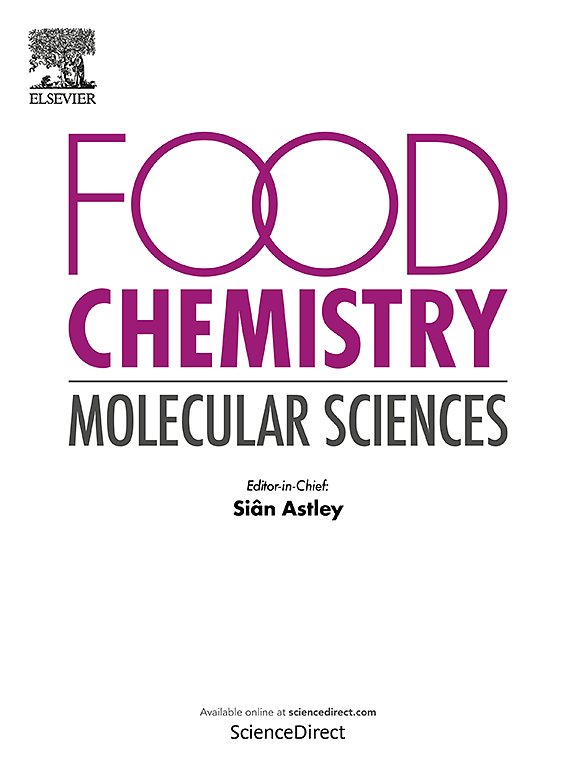一个李子晚熟突变品种果实品质的综合研究
IF 4.1
Q2 FOOD SCIENCE & TECHNOLOGY
引用次数: 0
摘要
果实成熟期是影响果实品质和商品价值的重要因素。研究为什么WSQCL比QCL晚15天成熟,为什么WSQCL有更涩的味道。通过对“晚熟强翠利”(WSQCL)、“强翠利”(QCL)和“翠红利”(CHL) 3个李子品种果实发育和品质动态的分析,探讨晚熟变异型WSQCL与其亲本品种在李子品质形成和成熟期方面的差异。结果表明:果实生长速度大小顺序为:QCL >;WSQCL祝辞的背影。3个李子品种果实发育过程中,可溶性糖(SS)、可滴定酸(TA)、淀粉、叶绿素、类胡萝卜素和酚类物质含量的变化是一致的,而总酚、SS和TA的积累在WSQCL和QCL之间差异显著。WSQCL中酚类化合物合成相关基因的表达量高于QCL,且酚类化合物合成与PAL3、4CL、HCT1、CHS的表达密切相关。主成分分析显示WSQCL与其他两个品种在果实发育中后期存在差异。本研究为WSQCL潜在价值的形成和开发提供了参考。本文章由计算机程序翻译,如有差异,请以英文原文为准。
A comprehensive study on the fruit quality of a late-ripening mutant variety of plum
The fruit ripening period is an important factor affecting fruit quality and commercial value.To investigate why WSQCL ripens about 15 days later than QCL and why WSQCL has a more astringent flavor. This study analyzed the dynamics of fruit development and quality of three plum varieties, including “Late-maturing Qiangcuili” (WSQCL), ‘Qiangcuili’ (QCL), and ‘Cuihongli’ (CHL), to explore the differences in plums quality formation and the ripening period between the late-maturing variant WSQCL and its parental cultivars. The results indicated that the order of the fruit growth rate was QCL > WSQCL > CHL. During fruit development of the three plum varieties, the changes in soluble sugar (SS), titratable acid (TA), starch, chlorophyll, carotenoids, and phenolic contents were consistent, while the accumulation of total phenols, SS, and TA differed significantly between WSQCL and QCL. WSQCL had higher expression of genes related to phenolic compound synthesis than QCL, and phenolic compound synthesis was closely associated with the expression of PAL3, 4CL, HCT1, and CHS. Principal component analysis revealed differences between WSQCL and the other two varieties during the middle and late stages of fruit development. This study provides a reference for quality formation and development of the potential value of WSQCL.
求助全文
通过发布文献求助,成功后即可免费获取论文全文。
去求助
来源期刊

Food Chemistry Molecular Sciences
Agricultural and Biological Sciences-Food Science
CiteScore
6.00
自引率
0.00%
发文量
83
审稿时长
82 days
期刊介绍:
Food Chemistry: Molecular Sciences is one of three companion journals to the highly respected Food Chemistry.
Food Chemistry: Molecular Sciences is an open access journal publishing research advancing the theory and practice of molecular sciences of foods.
The types of articles considered are original research articles, analytical methods, comprehensive reviews and commentaries.
Topics include:
Molecular sciences relating to major and minor components of food (nutrients and bioactives) and their physiological, sensory, flavour, and microbiological aspects; data must be sufficient to demonstrate relevance to foods and as consumed by humans
Changes in molecular composition or structure in foods occurring or induced during growth, distribution and processing (industrial or domestic) or as a result of human metabolism
Quality, safety, authenticity and traceability of foods and packaging materials
Valorisation of food waste arising from processing and exploitation of by-products
Molecular sciences of additives, contaminants including agro-chemicals, together with their metabolism, food fate and benefit: risk to human health
Novel analytical and computational (bioinformatics) methods related to foods as consumed, nutrients and bioactives, sensory, metabolic fate, and origins of foods. Articles must be concerned with new or novel methods or novel uses and must be applied to real-world samples to demonstrate robustness. Those dealing with significant improvements to existing methods or foods and commodities from different regions, and re-use of existing data will be considered, provided authors can establish sufficient originality.
 求助内容:
求助内容: 应助结果提醒方式:
应助结果提醒方式:


